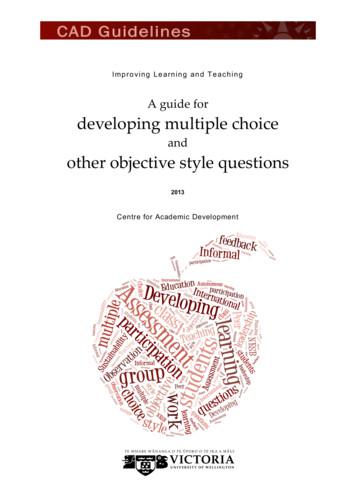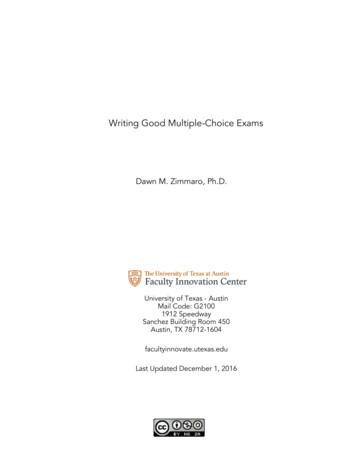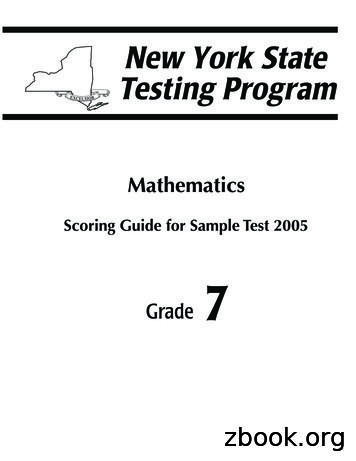Using Multiple Choice Questions In The Classroom
Using multiple choice questions in the classroomHow multiple choice questions can aid knowledge retention and helpteachers diagnose pupils’ understanding.Why might I use multiple choice questions with my students?There is a significant amount of research from cognitive psychologists such as Robert Bjork andDaniel Willingham that provides evidence to support what many of us might think – that repetitionin learning is essential for remembering. However, this research also shows that quizzing is moreeffective in remembering than restudying and that repeated frequent quizzing is even moreeffective. (If you want to learn more, then see the links at the bottom of the page)What is the point of using multiple choice questions with my pupils?One way of using multiple choice questions is as an aid to knowledge recall. As mentioned above,repeated use of these types of questions helps students to remember what they have learned.Another way is as a diagnostic tool for assessing what pupils understand and what they don’t. Here,carefully written answers can help the teacher diagnose exactly what misconceptions pupils have.How do I design effective multiple choice questions?When designing multiple choice diagnostic questions, there are two key principles to consider:1. questions should be rigorous2. questions should be informative to the teacher, that is, they ought to be diagnosticRigourThe rigour of the question is important in ensuring that the answer is not too easy to guess. Forexample:Whose death is remembered on Good Friday?a)b)c)d)JesusThe President of the USAElvis Presleymy teacherThis question is of little use because even if a student couldn’t remember who died on Good Friday,it is too easy to guess the correct answer.
A more rigorous question would be:Whose death is remembered on Good Friday?a)b)c)d)JesusLazarusJudasPontius PilateRigour in such questions can be increased in the following ways: proximity and plausibility of the answerso having answers that are either close to the correct answer or are plausible answersmeans it is much more difficult to guess the answer a wider range of answerso three answers gives a 33% chance of guessing right, but five answers means a 20%chance of guessing correctly. having more than one right answero this might mean having two correct answers, meaning students can’t always rely onpicking the first right answer they seeo having a set of correct answers where one is a better, more accurate answer thanthe others requires students to use judgement skills to arrive at the mostappropriate answer using negative questions or reversing the questiono use a negative question (Which of these is NOT the right answer?) encouragesstudents to read carefullyo a question could be set that seeks definitions of a key word could be reversed togive different key words for a definitionDiagnosticThe second key principle is that questions should inform the teacher of the level of understandingstudents possess by helping them diagnose any misconceptions held by students.This diagnostic element can be introduced into questions by regarding the following: incorrect options should be plausible, but unambiguously wrongo Implausible options reduce rigour, as seen above, while ambiguous answers causeconfusion
ooproviding plausible incorrect answers helps the teacher identify misconceptionsstudents may havelooking back at open-questions will help identify the frequent misconceptionsstudents hold and these can then be included in your incorrect answers it should be impossible for a students to get the right answer while still holdingmisconceptionso students should only be able to get the right answer if they have understood whatthey have been taught they can be answered in no more than 30 seconds.o they should be short because any form of multi-step question makes it more difficultto diagnose where the misconception is Stretch questions can be created with comparisons or connections between topics.o Opening out questions to include a synoptic element can be used to extend thisbeyond a single topic e.g. Which of the following is common to both Christianity andIslam?ExamplesBelow are some examples of multiple choice questions that are both rigorous and diagnostic. Anexplanation of each has been added to explain how the question meets the two key criteria.Q.Which of these statements best describes the conclusion of the Design Argument?a)b)c)d)e)The watch is complex so the world must be complexThe watch has a watchmaker, so the world must have a worldmaker.The watch was made but the world was not madeBoth the watch and the world were made by chanceThe watch and the world were made by GodEach of these statements include something about the watch and the world - students who have avague knowledge often know that these are involved, but don't know the specific details so this willquickly assess deeper knowledge. The wording also means that students cannot quickly skim readfor the key terms. They have to actually read each statement in order to choose and so it isgenuinely RE assessment as opposed to a test of literacy.Diagnostically, the student who picks E has clearly misunderstood the Design Argument and willneed to go over this again. Students who choose C and D will also need to revise the topic, whereasthe student who picks A probably understands the Design Argument and simply needs to think aboutthe wording of their answer.
Q.Christians believe in the idea of atonement. What does this mean?a) That Jesus was ‘at one’ with God.b) That Jesus’ death and resurrection mean that God let us off our sins by taking away ourpunishment.c) That Jesus paid the price for human sin so that God and humans could be reconciled.d) That because we are forgiven by God, it does not matter to God how we behave now.e) All of the above.Statement A involves misunderstanding of ‘at-one-ment’, though it sounds plausible both because ofthe proximity to the word atonement and the doctrine of the Trinity, with Jesus and God as one andthe same. Answer B would be selected by a student who forgets that punishment for sin is stillrequired by God, that “the wages of sin is death”. Answer C is the correct answer, while Answer Ddeals with a misunderstanding similar to answer B, that there are now no consequences for ouractions, while E would be selected by a students who thought that all of the above statements wereessentially saying the same thing.Further details:This guidance is based on three websites: Daisy Christodoulou’s blog, The Wing to Heaven, JoeKirkby’s blog Pragmatic Reform and Craig Barton’s site Diagnostic Questions.Each of these websites give practical and easy to understand explanations of how multiple choicequestions can be effective in the classroom.For more in-depth reading, try these: (click on the picture to follow the link to Amazon)Make it Stick: The Science of Successful LearningAn easy to read explanation of how memory plays a crucial role in learning.Why don’t students like school?Another straight forward and well written account of the how the research ofcognitive science can be applied to the classroom.And for even more depth:
Improving Students’ Learning With Effective Learning Techniques is a peer-reviewed paper by fivecognitive psychologists covering a century of research into this area.Robert Bjork’s research, Applying Cognitive Psychology to Enhance Educational Practice, containsYouTube video interviews in which Bjork explains his findingsUseful apps and websiteshttp://get.quickkeyapp.com/Quick Key marks multiplechoice questions done onpaper using yourphone/tablet as a scanner.Useful if your students do nothave mobile devices such asiPads.http://www.socrative.com/Socrative gives live feedback toteachers as students completemultiple choice questions in class.This app requires students to havemobile devices, though it can beused vis the website.https://quizlet.com/Quizlet is a flash card app(can also use the website),but quizzes can be set forhomework. Students canalso create their own flashcards for revision.
Using multiple choice questions in the classroom How multiple choice questions can aid knowledge retention and help teachers diagnose pupils’ understanding. Why might I use multiple choice questions with my students?
Developing multiple choice and other objective style questions 4 2. Writing multiple choice questions THE FORMAT of a multiple choice question Multiple choice questions are the most commonly used format for presenting objective-style questions. A multiple choice question consists of two parts ñ A stem and several options or alternatives.
Figure 1: A two-tier multiple-choice question in the format suggested in this paper, used in an exam in 2014. 2Description and design of our two-tier multiple-choice questions 2.1Basic structure of our two-tier multiple-choice questions There are several different ways to formulate two-tier multiple-choice questions. The type of
Test Blueprint 10 Preparing to Write Items 11 Description of Multiple-Choice Items 12-15 Multiple-Choice Item Writing Guidelines 16-18 Guidelines to Writing Test Items 19 Sample Multiple-Choice Items Related to Bloom’s Taxonomy 21-23 More Sample Multiple-Choice Items 24-25 Levels of Performance and Sample Prototype Items 26 Good versus Poor Multiple-Choice Items 27-28 Activity: Identifying .
50 multiple choice. 5. field test 40 multiple choice field test 46 ITEMS/40 POINTS 45 ITEMS/40 POINTS 55 ITEMS/50 POINTS 45 ITEMS/40 POINTS. 12 Students compose two essays one, for each of. two writing prompts. 40. multiple choice. 5. field test. 49. multiple choice. 1. open ended. 6. field test 50 multiple choice. 5. field test 40 multiple .
Grade 7, Book 1 Question Type Points Strand Content Performance Indicator Answer Key 1 Multiple Choice 1 Number Sense and Operations 7.N.9 C 2 Multiple Choice 1 Algebra 7.A.1 G 3 Multiple Choice 1 Statistics and Probability 6.S.3 A 4 Multiple Choice 1 Number Sense and Operations 7.N.6 H 5 Multiple Choice 1 Geometry 7.G.3 B
Other Species of Multiple-Choice Items In this chapter, we are concentrating on only one type of multiple-choice item—the one that has only one correct answer—but there are several other types of more complex multiple-choice items that you may want to consider. Some multiple-choice items are context
Running head: DOES CHOICE CAUSE AN ILLUSION OF CONTROL? 8 Koehler, Gibbs, & Hogarth, 1994; Langer, 1975; Nichols, Stich, Leslie, & Klein, 1996). In these studies, participants were randomly assigned to one of four conditions in a 2 x 2 design: Choice (Choice vs. No-choice) x Timing of Choice (Choice-first vs. Choice-last). Participants in the
(Corporate Officer). Full day event, get a hamper and 10 via expenses for drinks. Andrew Tamplin is doing a morning session, breakout rooms including a live band, quiz, virtual Christmas choir, guided meditation/yoga, virtual pub, pets corner, creative room (cooking workshops, magic tricks, circus skills). Dec 11th.























